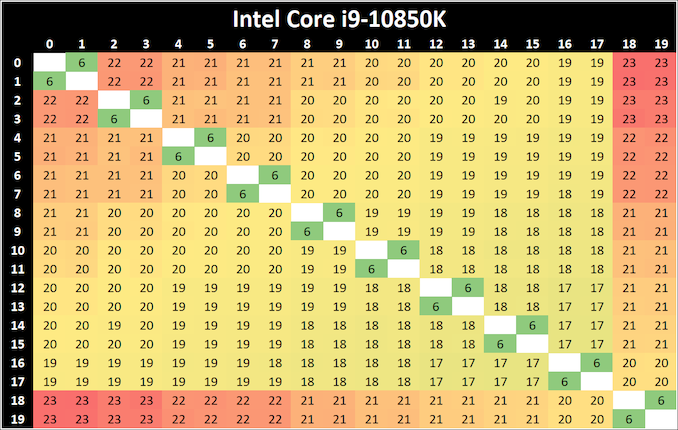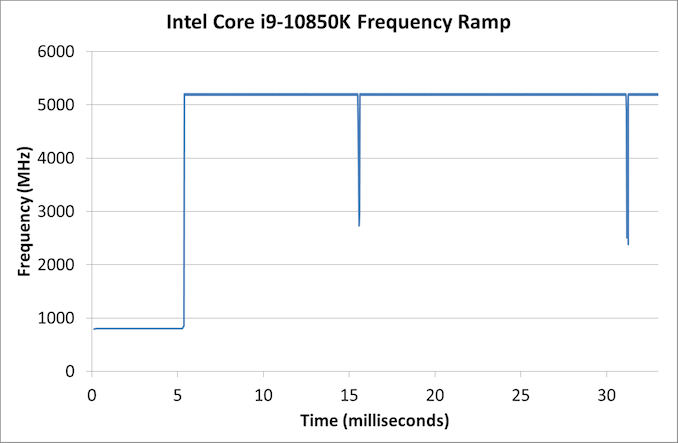Intel Core i9-10850K Review: The Real Intel Flagship
by Dr. Ian Cutress on January 4, 2021 9:00 AM EST- Posted in
- CPUs
- Intel
- Core
- Z490
- 10th Gen Core
- Comet Lake
- LGA1200
- i9-10850K
CPU Tests: Microbenchmarks
Core-to-Core Latency
As the core count of modern CPUs is growing, we are reaching a time when the time to access each core from a different core is no longer a constant. Even before the advent of heterogeneous SoC designs, processors built on large rings or meshes can have different latencies to access the nearest core compared to the furthest core. This rings true especially in multi-socket server environments.
But modern CPUs, even desktop and consumer CPUs, can have variable access latency to get to another core. For example, in the first generation Threadripper CPUs, we had four chips on the package, each with 8 threads, and each with a different core-to-core latency depending on if it was on-die or off-die. This gets more complex with products like Lakefield, which has two different communication buses depending on which core is talking to which.
If you are a regular reader of AnandTech’s CPU reviews, you will recognize our Core-to-Core latency test. It’s a great way to show exactly how groups of cores are laid out on the silicon. This is a custom in-house test built by Andrei, and we know there are competing tests out there, but we feel ours is the most accurate to how quick an access between two cores can happen.
When we first reviewed the 10-core Comet Lake processors, we noticed that a core (or two) seemed to take slightly longer to ping/pong than the others. We see the same pattern here again with the final core.
Frequency Ramping
Both AMD and Intel over the past few years have introduced features to their processors that speed up the time from when a CPU moves from idle into a high powered state. The effect of this means that users can get peak performance quicker, but the biggest knock-on effect for this is with battery life in mobile devices, especially if a system can turbo up quick and turbo down quick, ensuring that it stays in the lowest and most efficient power state for as long as possible.
Intel’s technology is called SpeedShift, although SpeedShift was not enabled until Skylake.
One of the issues though with this technology is that sometimes the adjustments in frequency can be so fast, software cannot detect them. If the frequency is changing on the order of microseconds, but your software is only probing frequency in milliseconds (or seconds), then quick changes will be missed. Not only that, as an observer probing the frequency, you could be affecting the actual turbo performance. When the CPU is changing frequency, it essentially has to pause all compute while it aligns the frequency rate of the whole core.
We wrote an extensive review analysis piece on this, called ‘Reaching for Turbo: Aligning Perception with AMD’s Frequency Metrics’, due to an issue where users were not observing the peak turbo speeds for AMD’s processors.
We got around the issue by making the frequency probing the workload causing the turbo. The software is able to detect frequency adjustments on a microsecond scale, so we can see how well a system can get to those boost frequencies. Our Frequency Ramp tool has already been in use in a number of reviews.
The Core i9-10850K ramps up extremely quickly from idle to peak turbo, in the region of about 5 milliseconds. This is faster than the 16 ms we typically observe.












126 Comments
View All Comments
Deicidium369 - Monday, January 4, 2021 - link
And TSMC is really killing the fabrication front with the inability to ship anything in meaningful numbers - due to a extremely fragile supply chain - other than Apple - everything else in still on some variation of TSMC's 10nm class process - they call "7nm"sadick - Monday, January 4, 2021 - link
You are right, but Intel desktop CPUs are manufactured on the 14nm process since 2014!!! Ok, it's 14++++ now, but what an evolution, I'm very impressed ;-)I'm not an AMD fan boy, actually using a i7-9700k!
regsEx - Thursday, January 7, 2021 - link
At least they are much cheaper. 10-core 10850K cost same as 6-core 5600X.Impostors - Monday, January 4, 2021 - link
So is apple? Lmfao you thought they were making the chips? TSMC isn't behind on production, they are the production for literally everyone, from PC to mobile.name99 - Monday, January 4, 2021 - link
"you could argue that was the right call given the state of the market"Only if you drank your own koolaid about the end of Moore's Law...
Remember a book called _Only the Paranoid Survive_? About how in High Tech there are *constant* upsets and changes, nothing ever stays the same?
Hmm, if only someone at Intel had read that book and though "Gee, this seems to describe an industry very much like the one in which we operate"...
0ldman79 - Saturday, January 9, 2021 - link
Playing it safe would have been fine if they had a product to release afterwards.Thing is they didn't. They got so cocky they screwed up their fabs, reached too far while physics are only getting tougher to overcome.
TSMC made 7nm work, whether it hit their target density and speed goals or not it works. Intel had a goal and rather than back off as needed to release a product they kept fighting to hit an ego check-mark. When 10nm didn't work they should have backed off the density and tried again in order to release a product. Ultimately that's what they had to do but they did it 3 years too late.
WaltC - Monday, January 4, 2021 - link
M1 has very little in software and hardware compatibility to recommend it, however. Those are the #1 reasons people buy computer systems--raw performance is merely icing on the cake. AMD blows the M1, and Intel CPUs, away, imo. As it sits today, the M1 is not competitive with AMD (or even Intel, actually) in terms of multithreaded performance desktops & enterprise-level offerings. I very much doubt Apple will be going there--but we shall see...M1 as it sits is a good beginner's start...let's see where it goes from there.Great_Scott - Monday, January 4, 2021 - link
The techie rant from the early 2000's is coming to pass, finally.So many programs are either mobile or browser-based that the M1 is going to get a pass on compatibility.
Apple got lucky on the timing, in other words.
name99 - Monday, January 4, 2021 - link
Geniuses (and genius companies) make their own timing...Seems kinda bizarre to consider the rise of mobile computing as an exogenous factor when discussing Apple!
Calin - Tuesday, January 5, 2021 - link
Just read an article about Flash no longer being supported... and it was instead replaced by HTML5 and the like...Guess that genius companies really are lucky indeed ;)